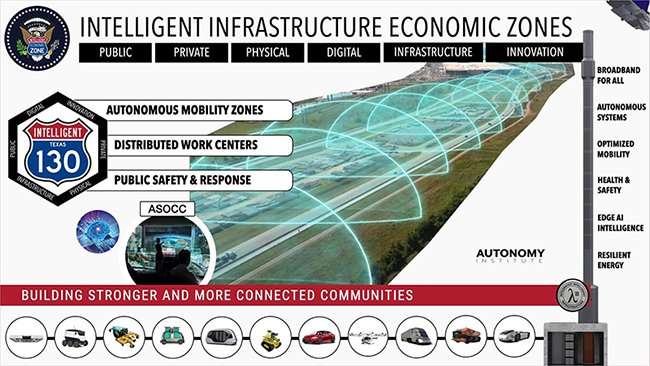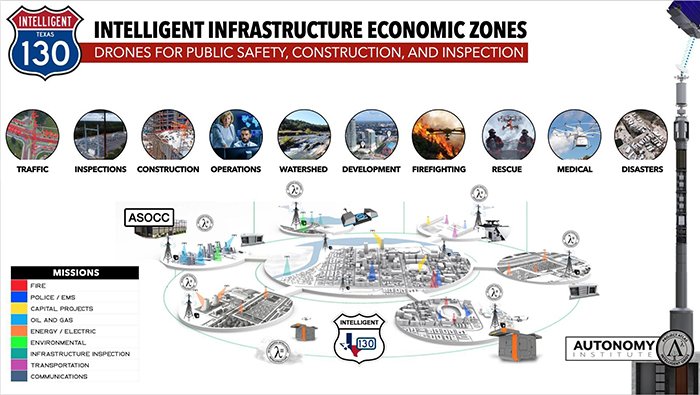The Autonomy Institute has announced Ondas Holdings Inc. as a lead commercial partner within the Intelligent Infrastructure Economic Zone (IIEZ) on Texas State Highway 130 (SH130). The initial design will enable ten drone zones to support high-traffic regions between the Circuit of the Americas and Georgetown, Texas.

These locations will support routine operations for inspections, security and public safety. The SH130 corridor has hundreds of companies and residential developments, including Tesla, Samsung, Amazon, Circuit of the Americas, HEB, and dozens of commercial developers. The City of Austin has identified over 100 drone use cases across a dozen departments, including Austin Energy, Austin Fire, Austin Water, City Planning, Police, Parks, Transportation, and Public Works. One of the Public Safety Training campuses for the City of Austin is also supported within the region.
“Ondas has assembled the leading autonomous industrial solutions within the drone industry; Ondas’ combined platform provides for resilient, scaled remote drone operations,” said Jeff DeCoux, Chairman of the Autonomy Institute.
Ondas, through its subsidiaries Ondas Autonomous Systems (OAS), American Robotics and Airobotics, offers industrial-grade autonomous drone solutions supporting remote operations and 24/7 operational zones. The Optimus System, a fully autonomous drone platform, functions as shared infrastructure for networked fleet operations, delivering aerial security and inspection services to commercial, industrial and public safety users along SH130. The installed Optimus fleets are managed remotely, eliminating the need for on-site human intervention. Drones are launched from smart airbases with automated battery swapping, ensuring continuous availability across a 30-square-mile area per zone. The Optimus System is already in use in the UAE and Israel, providing aerial data and security services across commercial and governmental markets.
“Ondas is excited to collaborate with the Autonomy Institute in deploying Intelligent Infrastructure, which has profound implications for the security and efficiency of our communities and underpins our nation’s long-term economic growth,” said Eric Brock, Chairman and CEO of Ondas.
Public and private operators are looking for ways to scale deployments and let them focus on doing their jobs. Commercializing drone operations with installed intelligent infrastructure supports expanded operations, allowing faster responses to fires, accidents, and other public safety and disaster response incidents. Increased drone utilization provides a growing volume, velocity, and resiliency of structured physical world data, solving for rapid edge data processing, machine learning, predictive analytics, and real-time communication and intelligence.
Texas has been a national leader in the adoption and operationalization of drones for public safety and disaster response.
“Texas is the undeniable leader in the use of UAS by public safety and the mission sets are as diverse as the state itself. Collaboration between state and local government agencies and increasingly with the private sector has been a force multiplier, leading to unprecedented success which we see expanding with the SH130 program,” said Jason Day at Texas Department of Public Safety.
Intelligent Infrastructure Economic Zones (IIEZ)

The Autonomy Institute establishes Intelligent Infrastructure Economic Zones. The collective expertise of our partners in software, hardware, and infrastructure contributes to a shared mission to accelerate a “path to commerce and productivity” for intelligent and autonomous systems.
Intelligent Infrastructure Economic Zones (IIEZ) accelerate the Civic & Market Economy by accelerating the formation of entrepreneurial and innovation ecosystems. These zones will support dozens of industry, community, and governmental stakeholders. They support community-inspired R&D to transition innovation to practice and stimulate workforce development.
Some of the robust use cases enabled that support open, inclusive, and sustainment in the region:
- Automated mobility districts to improve transport and access. Supporting autonomous cars, trucks, shuttles, drones, and dozens of other systems.
- Improved public safety and response.
- Sovereign Data Exchanges improve knowledge and information sharing with the community.
- Distributed works centers to end the digital divide.
- The advanced spatial computing capabilities support data connection and sharing for Active Digital Twins.
- Automated urban logistics to improve supply chain management and last-mile delivery.
- Telehealth to provide responsive health solutions region-wide.
- Intelligent Infrastructure Labs enable venture studios to accelerate innovation.
Automated Mobility Districts (AMD) and venture engines are among the most impactful. AMD provides advanced mobility to the elderly, disadvantaged, and communities outside current operations. Venture Engines compress the time to iterate and scale solutions by leveraging Intelligent Infrastructure. The model uses a pool of resources — capital, management processes, and talent — to accelerate the formation of start-up companies.
Intelligent Infrastructure Economic Zones are being embraced by an ecosystem of municipalities, real estate developers, engineering firms, construction companies, infrastructure investors, accountants, property and title companies, legal firms, energy producers, economic development groups, and university labs.
Private infrastructure investors are underwriting Intelligent Infrastructure Economic Zones, which include fiber, power, and new asset class such as Public Infrastructure Network Nodes (PINNs). PINNs enable robust edge computing, advanced wireless, and precise positioning enabling communities and regions with new services.
An analogy for how I2EZ can accelerate innovation is to compare it to Interstate Highways. Infrastructure investors funded the construction of highways, while innovation investors funded the development of future automobiles, roadway systems, hotels, restaurants, tourism stops, navigation tools, and truck stops.
Texas SH130 Intelligent Infrastructure Economic Zones (IIEZ)
In collaboration with hundreds of public and private leaders, the SH130 IIEZ has been developing for over four years. The 92-mile corridor impacts 10 Central Texas Counties, providing advanced services to dozens of communities and commercial developers. In January, FiberLight announced their $20 million investment for a 100Gb fiber connectivity to the Public Infrastructure Network Nodes (PINNs).
“SH130 is the modern-day equivalent of Route 66, supporting dozens of communities, and enabling 21st-century solutions,” said Jeffrey DeCoux, Chairman and Autonomy Fellow at the Autonomy Institute. “Intelligent Infrastructure touches the day-to-day life of each of our citizens and is crucial to competitiveness and prosperity.”
Intelligent Infrastructure enables solutions such as Artificial Intelligence, Spatial Computing, Intelligent Transportation, and Autonomous Systems. The IIEZ will provide 230 Intelligent Nodes, activating over 1.5MW of high-performance computing. Intelligent Infrastructure provides Sovereign Data Exchange that supports Active Digital Twin, AI Trust, and Cybersecurity Framework for autonomous systems.


